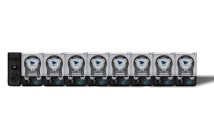
180 Gallon Reef Aquarium
Not everyone has the luxury of buying a brand new, high dollar aquarium. Brand new custom aquariums can be several thousands of dollars all by themselves, so a lot of people resort to buying used tanks. Buying a used aquarium can be quite dangerous though, since you don’t always know everything that has happened to the aquarium or how old it is. Hopefully though, the tips we’ll discuss will help you steer away from a bad purchase.
How old is the aquarium?

Saltwater Aquarium Plumbing
This may seem like an impossible thing to find out, but it really isn’t. Obviously you can ask the owner, but sometimes the owner of the aquarium may not be the first. It is not uncommon for people to be the third or even fourth owner of an aquarium. So to verify the age you’ll have to do some research. Look at the aquarium’s trim or design. These are usually pretty good indicators of the aquarium’s style. For example, older aquariums used different style overflow boxes or trim styles. It’s sort of like car shopping…you can point out the older models based on the style. If the style is too generic or you’re just not that well versed in aquarium history, many manufacturers have serial numbers or even dates somewhere on the aquarium. This information usually comes in the form of a tag of some sort that is in between the aquarium’s trim and glass. If the tank is custom, contact the manufacturer. Chances are they will be more than willing to look up the information for you.
What condition is the aquarium in?
The condition of the aquarium may seem like an easy, obvious thing. But it requires a keen eye and some work. Large cracks in the glass can easily be seen, but what about tiny scratches? More

180 Gallon Aquarium Obsessed Aquarium
often than not, an aquarium is going to have minute scratches somewhere. They may be in a corner near the bottom, but they may also be right in the middle of the main viewing pane. To find these scratches, ask the owner to fill the tank with water and turn the lights on. The fine scratches should be somewhat visible, but you’ll have to look hard.
Another thing to look at is the aquarium’s silicone. Silicone is what holds the tank together and prevents water from leaking. So check every inch of the corners and seams for tears in the silicone or any other damage. As with checking for scratches, ask the owner to fill the aquarium with water to verify that it does not leak. If the silicone is bad, don’t worry too much as it can be replaced. You can do it yourself (not recommended) or ask your local fish store for the name and phone number of a professional. If you decided to do the work yourself, you must remove all of the silicone and replace it all. You cannot replace just a small section, as it will be weaker than having a solid bead of silicone running throughout the aquarium.
Track down all of the previous owners!
If your aquarium has been owned by more than one person, ask the other owners about it. Sometimes this might not be easy to do, but in online aquarium communities things like this can be tracked down. The importance of this task is to really see how many times the aquarium has been moved. Moving an aquarium, especially larger ones, can be hard on the aquarium’s silicone. Draining the tank, picking it up, moving it around, and even letting it sit dry for any extended amount of time can damage or reduce the strength of the silicone bond. In addition to asking about moving the aquarium, you can also ask if they had any wave makers on the aquarium and any other details you’d like. Wave makers can be damaging to aquariums, especially larger ones. This is due to the amount of water that is being pushed back and forth against the glass.

Aquarium with Stand and Canopy
Inspect the Stand…
This is a bit easier to do visually. Just look for any water stains, damage, loose pieces, or funny smells. Also, make sure the stand is sturdy and note what kind of material it is made of. I’ve seen some pretty sorry stands in my day. For example, I went to a person’s house to break down and move their aquarium. The stand, believe me or not, was not held together with anything. It fit together like a puzzle and wobbled violently back and forth when you touched it. Once the aquarium was on it, the stand no longer wobbled. But I would never feel safe with a stand like that.
I hope this helps any potential used aquarium buyers. It’s always fun to find a sweet deal on an awesome tank, but take your time and do some research on it. Make sure your cheap upgrade doesn’t turn into an expensive nightmare.
All photos in this article were created by the author.





